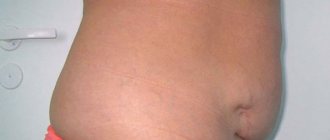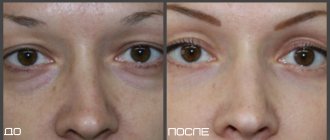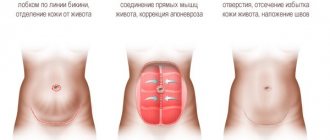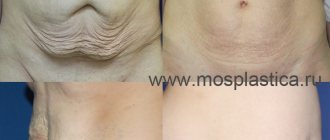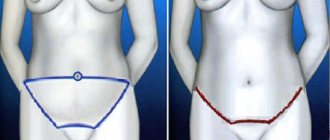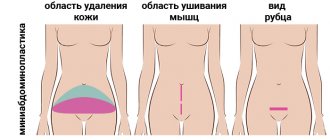The joy of motherhood is a priceless gift for every girl. However, it has another side: the body of a young mother is changing... The stomach suffers the most from postpartum changes - a sagging “apron” and stretch marks appear, muscles stretch, and the skin becomes flabby. Of course, every girl wants to return everything as quickly as possible to the way it was before giving birth. But many are stopped by the questions: “is it possible to give birth after abdominoplasty” and “how will childbirth affect the result of a tummy tuck”? We answer these questions and also tell you when it is better to have surgery in order to get a stable result for years.
Pregnancy after abdominoplasty
So, the main question for girls who dream of a flat and toned tummy is “is it possible to get pregnant in the future after abdominoplasty?” The firm answer from plastic surgeons is “yes”! Let's look at how a tummy tuck works.
The purpose of the operation is to restore the aesthetic proportions of the abdomen. That is: eliminate the overhang of the skin-fat “apron” and loose skin, remove fat deposits, and also close diastasis (separation of the rectus abdominis muscles) and hernia that could occur after the birth of the child. The surgeon makes a horizontal incision in the bikini area (slightly above the pubis), separates the skin and fatty tissue from the muscle, stretches it and removes excess. After this, a suture is placed on the surgical wound. It should be noted that in modern tummy tuck, “gluing” technology is used, when a special skin glue is applied to the seam.
Thus, the surgeon works with the skin, fatty tissue, muscles and fascia. At the same time, internal organs, as well as organs of the reproductive system, are not affected. Therefore, abdominoplasty cannot be a contraindication to conceiving a child or pregnancy. Carrying a baby is the same for both a girl who has had a tummy tuck and one who has not gone to a plastic surgeon. The performed operation does not affect the expectant mother and fetus.
Rehabilitation after mini abdominoplasty
In the initial rehabilitation period, the patient wears a bandage or compression garments. Recovery time for miniabdominoplasty is short; sometimes the patient is sent home the very next day after surgery. The rehabilitation period is 7-14 days. It is recommended to take a vacation during this time.
It's not just that you need to exert less physical effort. It is necessary to give the body the opportunity to fully activate its recovery resources.
Any operation, including mini-abdominoplasty, is stressful not only for the internal tissues in the area of surgical intervention, but also for general processes in the body: immune, metabolic.
You can, of course, force yourself to go to work. But general weakness and discomfort are clear signals that the body needs to be given the opportunity to recover. A calm lifestyle and a healthy diet during the rehabilitation period after mini-abdominoplasty will give results much faster, and in the future it will pay off handsomely.
By the way, about nutrition. Abdominoplasty does not affect the internal organs of the abdominal area. At the same time, during the recovery period it is worth paying close attention to your diet. It is necessary to exclude salty, spicy, fried foods. For the first two weeks, it is better to eat light food. Anything that complicates the digestion process (fatty meat, legumes) simultaneously causes blood flow to the abdominal cavity, and this is extremely undesirable after mini-abdominoplasty.
Restrictions also apply to physical activity. If you play sports, you will have to take a break for about 2 months. The same applies to any weight lifting.
All scars after miniabdominoplasty finally resolve after about six months.
Of course, external manifestations disappear much earlier, but physiologically the scarring process lasts about 6 months. During this time, you need to come to the doctor several times for a preventive examination.
In Moscow, many plastic surgery clinics perform miniabdominoplasty. To ensure that the operation is carried out at a professional level, carefully choose a medical institution and specialist. You should pay attention to the reputation of the clinic and reviews about it, the experience, work of the doctor in mini-abdominoplasty, his specialization in surgery.
In our clinic in Moscow, miniabdominoplasty is performed regularly by experienced specialists with extensive professional experience. Visit for a free consultation and find out about the possibilities of tummy tuck in your case!
Video
Example of mini abdominoplasty
Cost of mini abdominoplasty
| Name | Price |
| Excision of the abdominal fold due to deformation of its lower part (miniabdominoplasty) category 1 | 120,000 rub. |
| Excision of the abdominal fold due to deformation of its lower part (miniabdominoplasty) category 2 | 140,000 rub. |
| Primary appointment (examination, consultation) with a plastic surgeon | FOR FREE |
Possible complications from tummy tuck
Although pregnancy is possible after a tummy tuck, there are some things to consider:
- Abdominoplasty is an operation, which means the body needs to recover after surgery. Especially if we are talking about bearing a child, when the body requires a resource for a good pregnancy;
- natural processes during pregnancy: stretching of the skin, the appearance of stretch marks (stretch marks) and other aesthetic defects on the skin - can change the result of plastic surgery not for the better;
- if the delivery is by cesarean section, then another one will be added to the scar in the bikini area (after tummy tuck).
Why is it not recommended to have abdominoplasty if you are planning a pregnancy?
There are a number of contraindications to tummy tuck:
- acute and chronic heart and kidney failure;
- chronic diseases in the active stage;
- diabetes;
- oncological diseases.
Relative contraindications include planning pregnancy in the near future. Apparently, based on this, myths have arisen that abdominoplasty performed before pregnancy can negatively affect the further bearing of the child or complicate childbirth. But this is not true!
The main reason why abdominoplasty is not recommended before childbirth is that the operation is not practical!
After carrying a baby and giving birth, the abdominal muscles stretch again, the skin loses its elasticity, and the effect of the operation, which consists of tightening those same abdominal muscles, disappears. Yes, there is a high probability that the appearance of the abdomen after childbirth may not only return to its previous state, but also become even worse than before the operation. And then you will have to repeat the plastic surgery.
Model belly! What can abdominoplasty do?
Modern beauty standards are particularly demanding of a slim figure. Since nature and motherhood sometimes change the figure for the worse, people resort to various methods of losing weight and improving certain areas of the body. If sports, fitness and diets do not help, abdominoplasty can help. We talk about what kind of operation this is, how to prepare for it and maintain the postoperative effect with Petr Viktorovich Shelest, Candidate of Medical Sciences, plastic surgeon at the Expert Clinic Irkutsk.
— Pyotr Viktorovich, what is abdominoplasty? What is it for?
— Abdominoplasty is an operation to correct the anterior abdominal wall. It may be necessary for women after pregnancy and childbirth, after significant weight loss, in the presence of excess skin and fat deposits, as well as serious scar changes on the anterior wall of the abdomen.
— Tell us about the existing types of abdominoplasty and their differences.
— There are many methods for performing this operation. Conventionally, there are two large groups – mini abdominoplasty and true (full) abdominoplasty. They differ in that in the first case the surgical intervention does not involve moving the navel, and in the second it is performed with moving the navel.
Full abdominoplasty is accompanied by plastic surgery of the anterior abdominal muscles, removal of hernial protrusions, excess skin and subcutaneous fat with navel transfer.
Mini abdominoplasty is used much less frequently and is indicated for women at a young age in the absence of sagging skin on the abdomen.
People with severe abdominal obesity, as well as women after several births, may experience separation of the rectus abdominis muscles - diastasis. In this case, abdominoplasty is performed to eliminate diastasis of the rectus abdominis muscles. Occasionally, it is necessary to perform endoscopic abdominoplasty using special equipment through small punctures in the anterior wall of the abdomen.
The operation is performed under general anesthesia. Depending on the type of intervention, its duration ranges from one and a half to four hours.
— Is abdominoplasty a procedure only to eliminate cosmetic defects or can it be prescribed for therapeutic purposes?
— Despite the fact that abdominoplasty is performed only by plastic surgeons, this operation not only helps to correct cosmetic defects, but also has therapeutic purposes, namely, the elimination of discrepancies in the rectus abdominis muscles and hernias, if any. In addition, pronounced deforming scars on the abdomen can cause pain to patients, so their removal leads to both a cosmetic and therapeutic effect.
— How do patients prepare for tummy tuck?
— Usually, a few days before the procedure, a comprehensive examination is carried out, including not only general blood tests, urine tests and an assessment of the cardiovascular and respiratory systems, but also an ultrasound of the abdominal organs. If the patient suffers from a concomitant pathology, consultations with related specialists - a gynecologist, endocrinologist, nutritionist and others - may be necessary.
— What recommendations do you give to patients after abdominoplasty?
— On the first day after surgery, patients must lie down, the next day they are allowed to get up and walk around the ward. During the early recovery period (within two weeks, when dressings are performed), you must be extremely attentive to your health. It is at this time that complications may arise, in particular, a seroma (accumulation of tissue fluid) may form, which must be removed in a timely manner.
I would like to note that during the period of early rehabilitation it is recommended to sit as little as possible; you should try to either lie down or walk.
In the next two months after abdominoplasty, it is mandatory to wear compression garments, namely a postoperative bandage. During the first month, I recommend wearing it around the clock without taking it off, after which it is acceptable to unfasten it at night. For six months, there remains a restriction on lifting weights of up to five kilograms.
Six months after this intervention, patients return to everyday life. It is important to continue to ensure that physical activity is moderate and nutrition is balanced.
— How long does the effect of the operation last?
— It directly depends on the patient himself. If after it he leads a healthy active lifestyle, then the effect will be lifelong. Excessive exercise, poor nutrition, excess weight gain, and physical inactivity can negate the results obtained after surgery.
— Are there any contraindications to abdominoplasty?
- Yes. One of the main ones is obesity. In addition, surgical correction of the anterior abdominal wall is not performed on patients with chronic diseases in the acute stage: diabetes mellitus, decompensated arterial hypertension, coronary heart disease, and some diseases of the respiratory system.
The psychological status of the patient is also extremely important. He must clearly understand what he wants and what he can get from the operation. Therefore, our clinic always conducts a preliminary conversation with patients, where they receive answers to all their questions.
For reference:
Shelest Pyotr Viktorovich
In 2000 he graduated from the medical faculty of Irkutsk State Medical University.
In 2002, he completed his clinical residency in surgery.
Since 2008 he has been practicing plastic surgery. Candidate of Medical Sciences.
He is the chief freelance plastic surgeon at the Ministry of Health of the Irkutsk Region.
He holds the position of Deputy Chief Physician for Surgery at Clinic Expert Irkutsk. Receives at the address: st. Kozhova, 9A.
Does this mean that abdominoplasty is contraindicated before childbirth?
Not at all! Of course, the bulk of a plastic surgeon’s patients are women after childbirth who want to restore their pre-pregnancy shape. But, it is important to understand that a tummy tuck is not always performed for aesthetic purposes. It is also carried out for medical reasons. For example, in the presence of significant diastasis - divergence of the rectus abdominis muscles in different directions, or a hernia.
Of course, it is better if abdominoplasty takes place after childbirth. This is the key to stable results for life. But surgery performed before pregnancy will in no way harm either the mother or the child or interfere with the proper growth and development of the baby.
Repeated tummy tuck after childbirth
And the second side of the situation is childbirth after abdominoplasty. In most cases (based on practice, 70%), subsequent births after plastic surgery will lead to deformation of the anterior abdominal wall. The “apron” on the abdomen, loose skin, stretch marks will appear again... And then a repeat abdominoplasty will be needed. Surgical intervention is performed in the same way as before childbirth. By the way, there is an opinion that a tummy tuck can be performed simultaneously during childbirth. Indeed, such a practice exists, but we recommend not to combine these processes.
It is worth noting that in some cases large-scale abdominal deformation does not occur, and then only minor correction is performed.
Before deciding to undergo a tummy tuck, consult with a plastic surgeon and consider the pros and cons.
Minabdominoplasty technique
The mini-abdominoplasty technique is as follows: the surgeon makes an incision along the bikini line (so it will be hidden with underwear). Next, excess skin and subcutaneous fat are removed from the lower abdominal wall and, if necessary, the muscles of the lower abdomen are tightened. Liposuction of the abdomen is very often performed.
On average, the operation lasts from 1 to 2 hours and is performed using general or local anesthesia (less often).
The size of the abdominal scar after miniabdominoplasty varies greatly depending on what data the patient came with. If there are large fat folds on the sides, you will have to do liposuction of these areas. If the area of the lift is small or practically no skin excision is required, the incision during mini-abdominoplasty is sometimes invisible.
